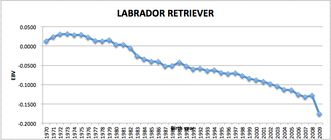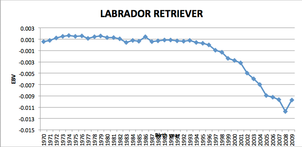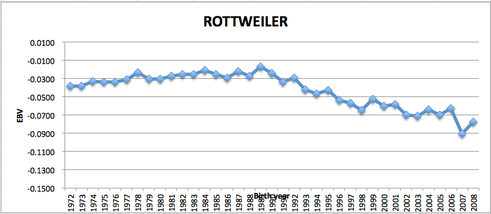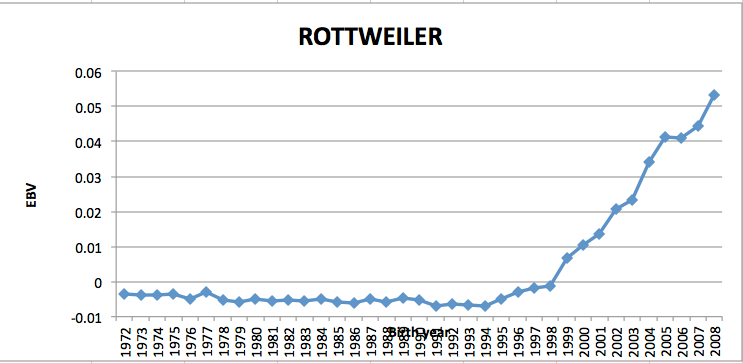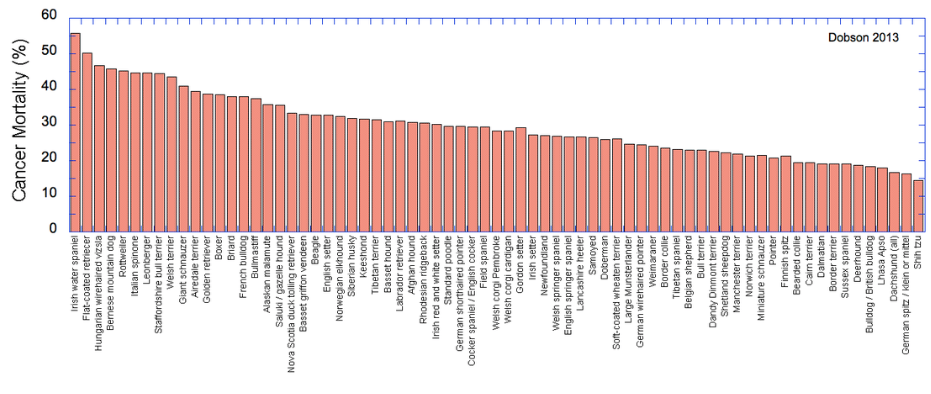You can look up individual and breed statistics for hip and elbow scores of US dogs on the OFA website, and OFA has even pulled out the data for the last few years (e.g., 2006-2010) for comparison with the data for all years. I have graphed these data various ways to make it easier to compare breeds, and I have also done the recent years separately for a "recent" snapshot.
This is about all you can do with a table of numbers for breed averages as presented on the website. However, if you can marry the data for individual dogs to their pedigree information, you can extract information that is vastly more useful to breeders. If you have information for a particular trait - not just for an individual dog, but also for its relatives, parents, siblings, offspring, uncles and aunts, cousins and so on - you can get a much better idea of what hides in the genes of that dog than by using simply phenotype.
For instance, a dog with great hips has high "breeding value" for that trait, but dogs with great hips don't always have progeny with great hips. You could make better predictions about the breeding value of a dog for a specific trait if you had information about not just its phenotype, but also its genotype. What you REALLY want to know is whether a dog has good hips because he has good genes for hips (the genetic component of a trait), or if he spent the first 6 months of puppyhood lolling on sofa cushions and rolling in tall grass (the environmental component), versus bounding up and down concrete stairs and jumping off wine casks in the cellar. If he has good genes, he will pass those on to his offspring.
You can get a statistical estimation of a dog's breeding value by including information for relatives. This "estimated breeding value" (EBV) is a far better predictor of the genetic merit of a dog than you can get by poring over pedigrees trying to figure out if you need to be worried about Uncle Rocky's one bad elbow, or that one puppy in the last litter that seemed fine as a puppy but didn't get a gold star on his hip exam. Computation of a dog's estimated breeding value takes all of these things into consideration and provides a number that is an index of that dog's genotype - how good its genes are for that particular trait.
EBVs have been widely used for decades by breeders of livestock, birds, horses, pigs - pretty much every domestic animal, except dogs (except breeders of service dogs such as guide dogs). Only recently have a few kennel clubs started providing EBV values for particular traits in some breeds of dogs (e.g., the UK Kennel Club, the Finnish KC), and there seems to be universal agreement among those with an opinion that using EBVs would substantially improve the ability of breeders to reduce the incidence of hip dysplasia.
A study published in 2013 by Hou et al used the public OFA data for hips and elbows, together with the pedigree information, to run EBV statistics for 74 breeds of dogs, looking for evidence of improvement (or not) in hips and elbows over time. Buried in the supplemental online documents for that study are a series of graphs that contain valuable data for breeders, a couple of examples of which I include below. (Graphs for all breeds in the study are here.)
EBVs for Hips (left) and Elbows (right)
This information is great for displaying progress over time. But as the authors of this study point out, breeders were able to improve the hips and elbows of their breeds using only phenotype for selection. If they had the EBV data for individual dogs, they should be able to substantially improve the rate of improvement by selecting those dogs to breed with the highest genetic merit for the trait. Genetic gain would be faster and more efficient, reducing the number of dogs that would suffer debilitating orthopedic problems, not to mention the expense of caring for them, in both dollars and heartache.
Wouldn't it be great if OFA was providing these data online, updated yearly or more often, so breeders could get the EBV scores for individual dogs so they can objectively evaluate the quality of a dog's genotype for a particular trait? Wouldn't it be great if breeders could see if their efforts at managing these serious orthopedic problems in their breed were effective? OFA has the data. If OFA won't do it, wouldn't it be great if CHF could provide the funding for somebody else to do it? I tried to convince both how valuable this information would be a few years ago, to no avail. (Even though OFA has advocated using EBVs in a recent publication; Keller et al 2011) This is not something breeders can do themselves, but the data - and lots of it - are available, and not just for hips and elbows but for ANY trait or health problem. If you think this information would be useful to you and other breeders, let OFA and CHF know. I want to know what happened to Labrador elbows in 2010...
You can see the data for all the breeds in the study here.
Hou Y, Y Wang, X Lu, X Zhang, Q Zhao, RJ Todhunter, & Z Zhang 2013 Monitoring hip and elbow dysplasia achieved modest genetic improvement of 74 dog breeds over 40 years in USA. PLoS One 8(10). (pdf)
Keller GG, E Dziuk, and J Bell 2011 How the Orthopedic Foundation for Animals (OFA) is tackling inherited disorders in the USA: using hip and elbow dysplasia as examples. Vet J 189: 1970202.
And join the discussion in our FACEBOOK GROUP - ICB Breeding for the Future
